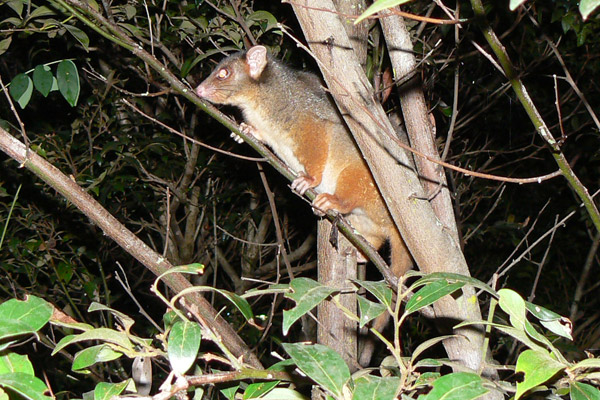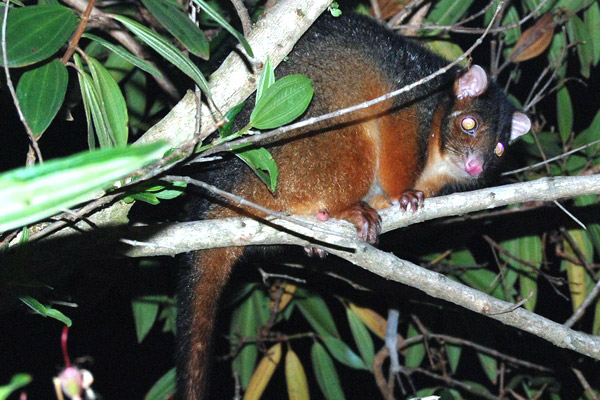Pseudocheirus pereginus
Other Common names: Grey Queensland Ringtail, Banga, Rufous Ringtail, South-eastern Ringtail
Physical description:
- Ringtail colour is variable; silver-grey, smoky-grey, dark grey-brown but more typically light grey or rich red on back and sides.
- Cream to grey underneath, with red or tan on the arms. The ears are short and rounded with a white patch on the back. Average body length 300-350mm, weight approx. 700-1.2kg.
- The prehensile tail is slender, with white on the lower portion covering half to a third of the length. Used to grasp branches while climbing and carrying nesting materials.
Ecology
- Arboreal (tree-living) occupying a variety of habitat types across Australia; prefers rainforests, eucalyptus forests and woodlands, and thick vegetation along watercourses, parks and backyard gardens.
- Nocturnal, spending daylight hours in tree hollows or dreys constructed of twigs, bark, leaves and grasses, situated in the forks of limbs or among the branches.
- Natural diet consists of fruits and flowers, particularly those from eucalyptus trees. A specialised leaf-eater, they are one of a few marsupials which can feed on eucalyptus leaves.
- Common ringtail possums live in social groups, unlike brushtail possums, of up to 5 individuals, sharing food and nesting resources. Young leave after 8-12 months to establish their own territories.
- Threats include; land clearing and loss of habitat and in urban areas attacks by cats & dogs.
Breeding
- Common ringtail possums breed from Autumn through to Spring, with northern species giving birth at the beginning of the season.
- Established pairs can produce 2 litters within the season, thought this is not consistent throughout the entire range of species.
- Females reach sexual maturity at 14 months; males 13 months. The gestation period for these animals is unknown, with 2 young generally born.
- Young remain in the pouch for 4 months, and are on mum & dads back permanently from 120 days. Weaning established at 180-220 days.
- After leaving their parents, mortality rate is high until sexual maturity and own territories are established.
Suburban Ringtail Possums:
- Although they can readily adapt to urban environments, ringtail possums prefer to nest in dense bush remnants rather than around buildings, and therefore rarely become a nuisance.
- Backyard gardens and parks with abundant flowering and fruiting trees can be regularly visited by foraging individuals and allow for higher densities of family groups.
 Living with Ringtail Possums
Living with Ringtail Possums
Ringtail Possums are rarely a problem in comparison to brushtail possums but they are known to take advantage of fruiting and flowering plants in suburban backyards.
Advice & Management
If your best efforts of excluding your possum/s fail then further advice and assistance may be your last resort.
Ecologically-minded possum advice, specialist trapping requirements, and legislative compliant release methods should be employed by licensed professionals for effective possum management.
Contact – your local licenced possum specialist. For Brisbane and surrounds call Peter the Possum Man on (07) 3250 1111.
Trapping and further management of ring-tail possums should be done in accordance with requirements stipulated by the Environmental Protection Agency and permits are issued to operators after examination as to the knowledge and suitability of the permit holder to actively manage suburban possums. Often these permit holders are able to provide proofing measures to exclude further entry.
Possums should not be relocated more than 25 meters from the point of capture after proofing has been conducted. Be sure to ask contractors what methods they employ and choose the one which provides a solution for yourself and the best welfare outcome for the possum/s being trapped.
